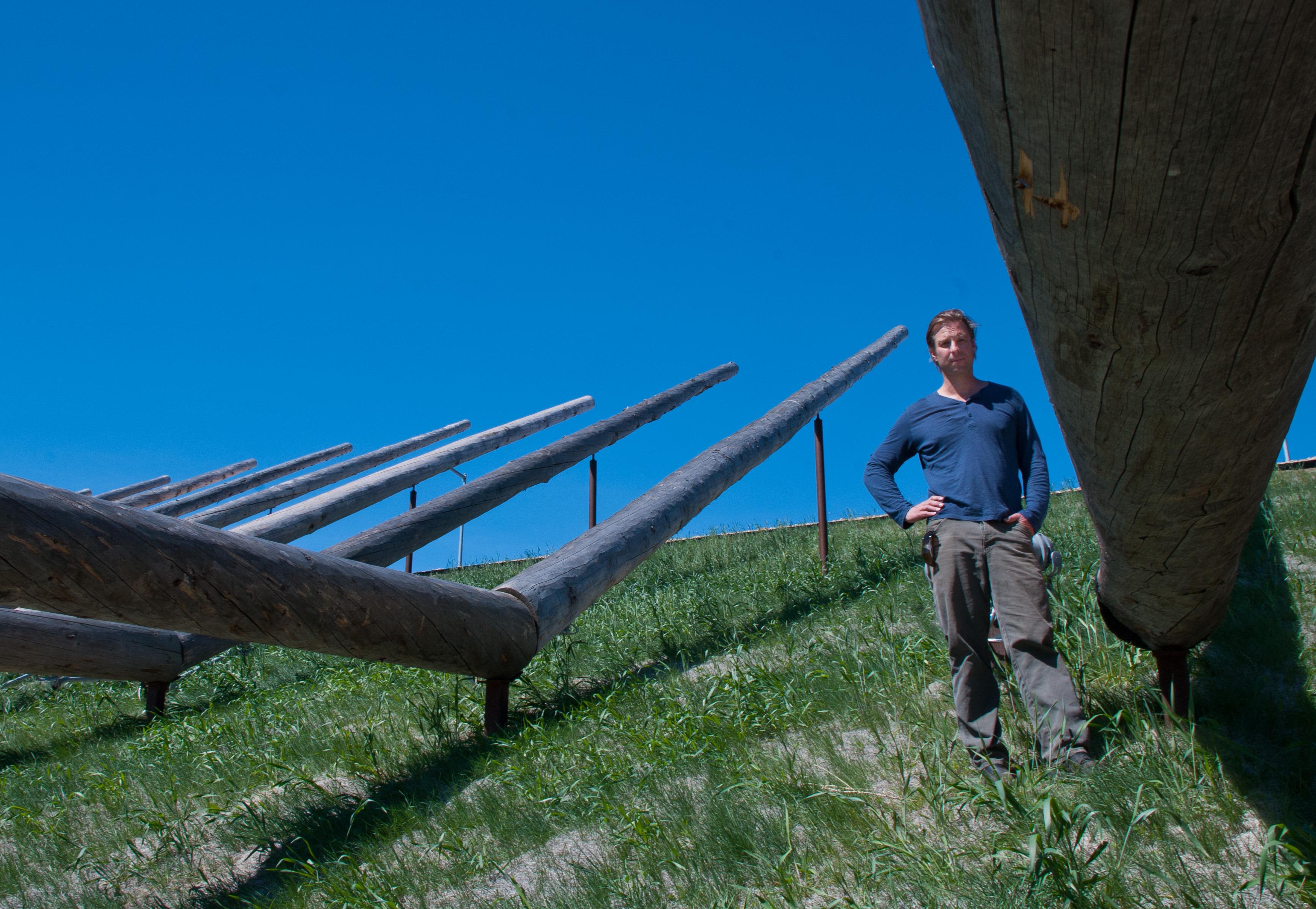
This story is part of a reporting project to understand public art in Colorado, how it's funded and the impact it has.
When Susan Davenport steps off the new train that links Union Station to Denver International Airport, something massive greets her near the DIA platform.
"We see this elaborate display of logs apparently in some kind of a pattern," the Denver resident says. "But we don’t know what the pattern represents.”
Davenport came to DIA to check out the airport's recent changes now that the Westin Hotel and the Transit Center are finished. The new development also brings six new public art installations that together cost about $6 million.
That includes DIA's single most expensive commission yet, which is made up of 236 logs that surround the train platform. There isn't a plaque up yet to explain what this art is. So Davenport has some questions.
“I would be interested to know who the artist is and know a little bit more about the story,” she says.
'Public Art Is About Familiarity'
The sculpture is called "Shadow Array." It's by Denver artist Patrick Marold. He says all these logs come from trees killed by beetles in Colorado’s Rio Grande Forest. Beetle kill trees get removed to reduce forest fires and infestation. So it occurred to Marold he could reuse them for art.
"You can see the shadows are right there on the landscape," Marold says. "That was the intention of this piece all along -- to really take advantage of the solar exposure."
These are long logs. Some stretch about the length of a tennis court. And the logs cast long shadows, which change based on the angle of the sun.
The piece is inspired by Colorado’s landscapes, Marold says. The wood is a nod to the mountains, while the shadows call attention to the harsh sunlight in the eastern plains. He says it’s meant to remind people where they are.
"I think public art is about familiarity and starting to understand your surroundings through the art,” Marold says.
The sculpture took the artist and his team more than three years to complete. His budget was more than $2 million. Another $4 million went to five other installations in and around the Hotel and Transit Center.
That includes a 150-foot wall mural called "Strange Continents" by Denver artist Mindy Bray inside a hallway on the first level of the Westin Hotel. The piece, which resembles a map, is based on photographs of the Platte River along Denver's Confluence Park.
Then there's Wopo Holup's work “Colorado River” near the hotel's conference center -- if you're there, look up to find it. Made from metal and gold leaf, the sculpture represents sections of the Colorado River.
DIA says it will place plaques near the artworks to identify them.
What New Art You'll See At DIA
DIA's public art collection now has 35 pieces. That includes the giant blue horse known as "Mustang." They are all part of Denver’s own public art program.
A 1991 ordinance requires that the city’s major construction projects set aside money for art. When Denver completes a capital improvement project that costs more than $1 million, 1 percent of the budget goes toward art for the site.
“This airport is just one giant capital improvement project, so they have public art going on all the time,” says Kendall Peterson. She was hired to manage the public art for DIA’s new Hotel and Transit Center.
The committee that chose the artists included airport staff, community members, artists and curators. They sought bigger pieces that were more than decorative, Peterson says. That’s because flying can be stressful for travelers.
"We wanted artwork that would make them pause for a little second and make them look at something like a kinetic sculpture and really kind of calm them down,” she says.
So DIA installed the artworks in places where people will linger. “Water In All Of Its States” by Paris-based Yann Kersalé features a lighting design and 3D video screen you can watch as you ride an escalator. And the outdoor plaza on the fifth level has 18,500 aluminum blades that mimic grass and they move when the wind blows. California artist Ned Kahn created the piece, titled “Field of Air.”
“Normally art is definitely relegated to a certain group of people," Peterson says. "Here you have it everywhere, and these are top-notch artists.”
How DIA's Public Art Gets Funded
There is one big difference between public art at DIA and public art in the city: Who pays for it. Pieces in the city, such as in parks or outside municipal buildings, get funded with tax dollars. But public art at DIA doesn’t. That’s because the airport is known as an “enterprise fund.”
“DIA operates like a government-owned business,” DIA spokesperson Stacey Stegman says.
So while the airport is a city agency, it generates its own revenue. That money comes from different things, like airliner landing fees down to that cup of coffee you buy before a flight.
“All those things combined generate about $900 million a year to the airport specifically,” Stegman says.
Some of those dollars go toward art, as mandated by the city’s public art ordinance.
Now there is some disagreement over the entire project cost for DIA’s new Hotel and Transit Center.
Last year, Denver's city auditor released a report that says the cost could exceed $720 million. However, the airport's estimate is around $586 million. An external auditor is now working to help both sides sort it out, and a consensus on the actual cost is expected soon.
"The hope is that this kind of analysis will improve the city’s budgeting and cost containment in the future," city auditor spokesperson Kathleen MacKenzie says.
DIA officials maintain the city auditor has included other capital improvement expenses that should not be lumped in to this total.
"The biggest fight is do we call it one project or multiple," airport spokesperson Stegman says. "Either way it’s still the same bottom line, and we’ve set aside that money from those projects [for art].”
In the meantime, construction continues at the airport. Concourse C has five new gates. And DIA plans to redesign Jeppesen Terminal's Great Hall and to develop its Aerotropolis -- a community around the airport. All of this work means more art to come.
"We think art also serves a huge purpose in this redevelopment, and we’d be looking at how to integrate that into this construction," Stegman says.
What pieces of public art in your community catch your attention and why? Snap a photo and share your comment or question below in the comment section or on Facebook and Twitter.








